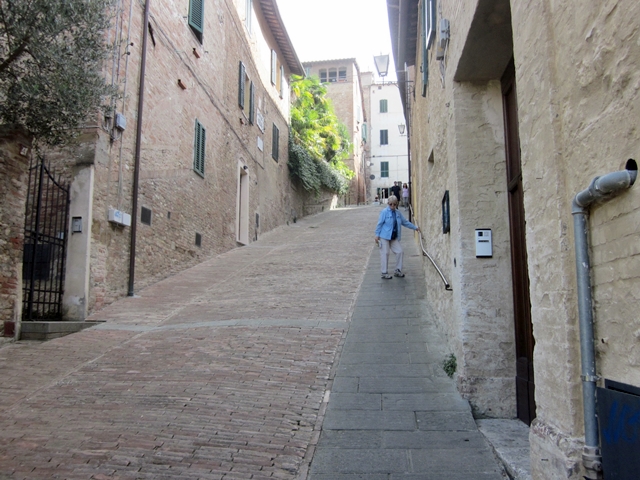The Uffizi Gallery
Today was a GCT” free day (No GCT “free” tours today). So, this Morning we had tickets (bought at home via the Internet) for 9AM at the Uffizi Gallery so we ate a quick breakfast, made up our scavenge lunch and hoofed it to the museum near the Arno River. We got there on time, rented a talking guide headset, took our maps and started our tour.
At this point, I’ll confess to be pretty ignorant about Renaissance art and I was not able to scribble fast enough to get names of paintings so I’ll just show you some of the many, many we saw: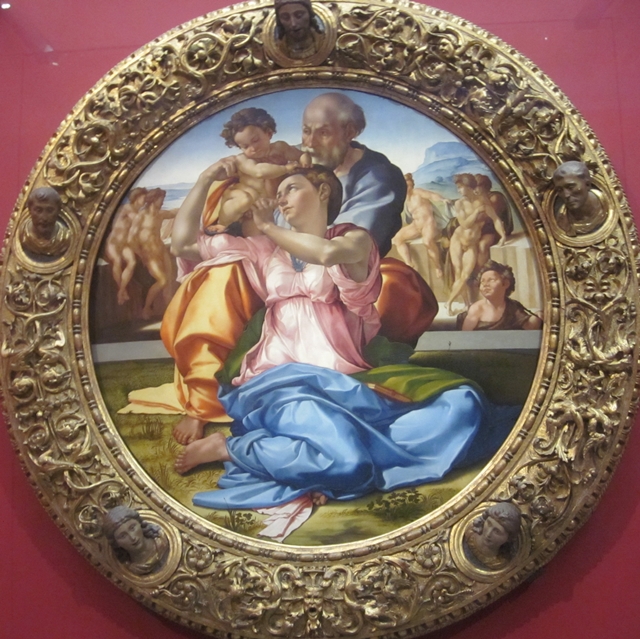

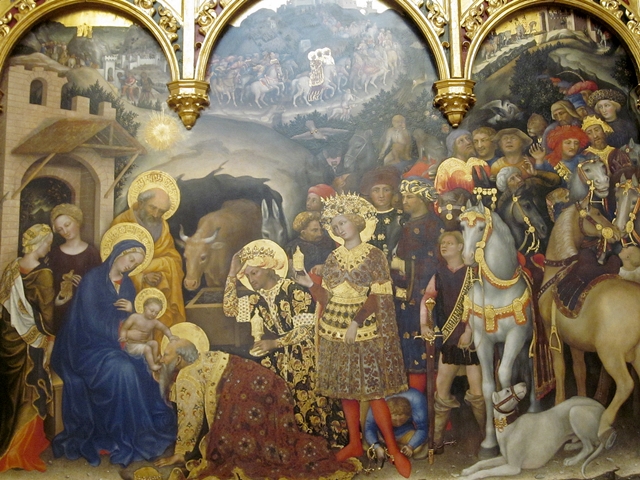
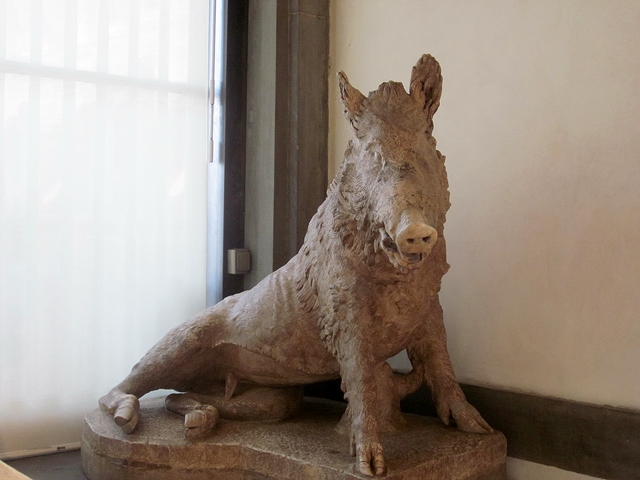
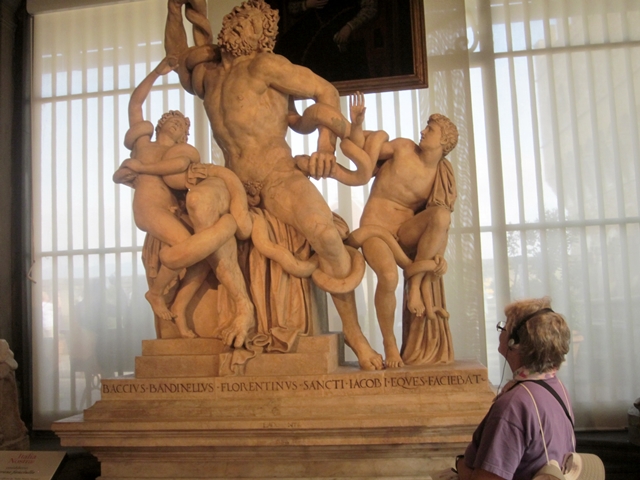
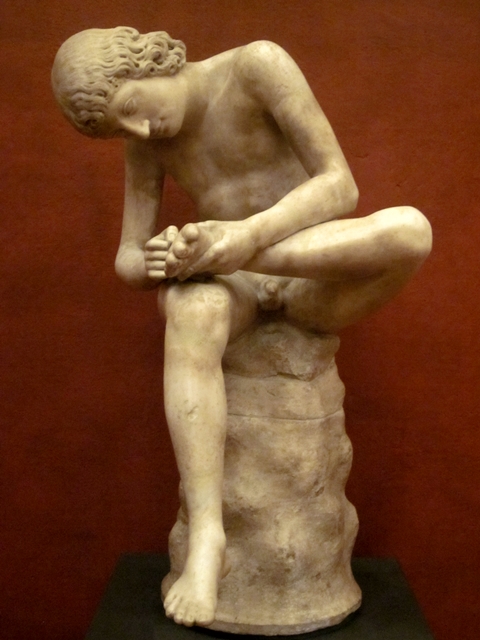
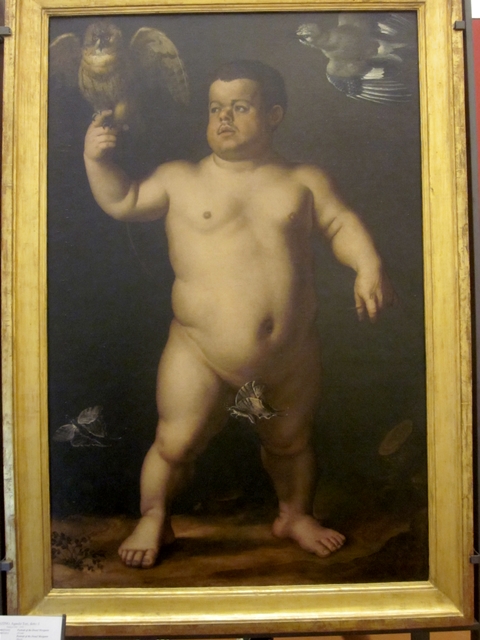



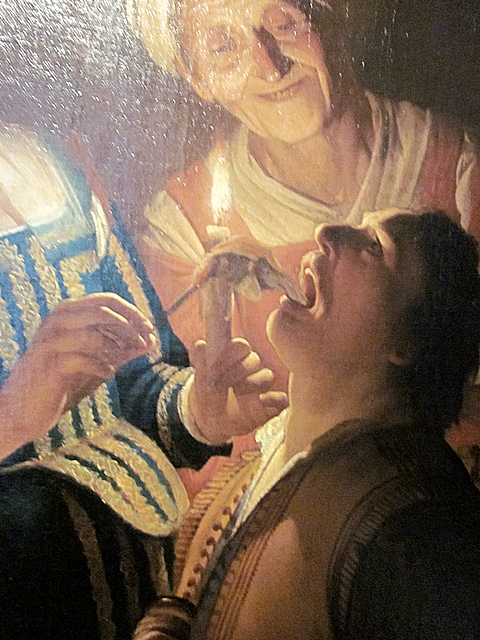 The last two are neat: Medusa turning to stone after seeing her owu reflection and the details of the tooth pulling. Both depict open mouthed agony…
The last two are neat: Medusa turning to stone after seeing her owu reflection and the details of the tooth pulling. Both depict open mouthed agony…
The two views of the dwarf were done by a painter to show that a flat painting could show a subject front and back – just like a statue.
We spent 6 hours in the Gallery. Our group left at noon without us for an “Optional” (not free) trip called “the Treasures of Tuscany”. This was comprised of a long bus ride through the Tuscan countryside, a stop at the hill town of San Gimignano, and a tour with dinner at at Castello Oliveto. We hadn’t signed up for this option so we enjoyed an unhurried Uffizi tour and a leisurely “Lupper” (lunch and supper combined).
After Lupper we walked to the train station to look into train tickets to Siena. The group had an”optional” (not free) scheduled trip to Siena tomorrow. Round trip for two on the train from Florence to Siena and back was 30 Euros (about$40). This compares to GCT’s $240 for the same trip (escorted and narrated). Lunch would be “on your own”. To us it was a “No-Brainer” plus the train ride should be a fun adventure.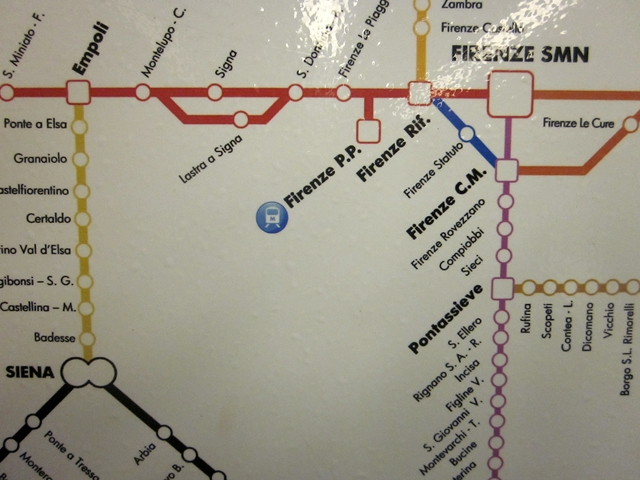 Here is the train route to Siena. It looks pretty simple so we bought tickets.
Here is the train route to Siena. It looks pretty simple so we bought tickets.
 The train was clean, fast, and comfortable. Our only snag was when the conductor asked for our tickets. We had the tickets, but they weren’t stamped at Florence with the time validation. He handed us a paper printed in several languages that said, in brief, that there was a 40 Euro fine apiece for unvalidated tickets. He saw we were tourist and after a long pause, he kept going. Double Whew!
The train was clean, fast, and comfortable. Our only snag was when the conductor asked for our tickets. We had the tickets, but they weren’t stamped at Florence with the time validation. He handed us a paper printed in several languages that said, in brief, that there was a 40 Euro fine apiece for unvalidated tickets. He saw we were tourist and after a long pause, he kept going. Double Whew! Our first stop was at the “Piazza Del Campo”. It is the principal public space of the historic center of Siena and is regarded as one of Europe’s greatest medieval squares. It is renowned worldwide for its beauty and architectural integrity. The Palazzo Pubblico and its Torre del Mangia, as well as various restaurants surround the shell-shaped piazza.
Our first stop was at the “Piazza Del Campo”. It is the principal public space of the historic center of Siena and is regarded as one of Europe’s greatest medieval squares. It is renowned worldwide for its beauty and architectural integrity. The Palazzo Pubblico and its Torre del Mangia, as well as various restaurants surround the shell-shaped piazza.  I found this shot of the Piazza del Campo on the Internet. It showed the size of the Piazza, the Palazzo Pubblico (Town Hall), and the Torre del Mangia, The Torre del Mangia was built in 1338-1348. When built, it was one of the tallest secular towers in medieval Italy at 289 feet. Literally meaning ‘Tower of the Eater’, the name refers to its first bellringer, Giovanni di Balduccio, nicknamed Mangiaguadagni (‘eat-the-profits’) for his spendthrift tendency or his idleness and gluttony. Any relation to Quasimodo?
I found this shot of the Piazza del Campo on the Internet. It showed the size of the Piazza, the Palazzo Pubblico (Town Hall), and the Torre del Mangia, The Torre del Mangia was built in 1338-1348. When built, it was one of the tallest secular towers in medieval Italy at 289 feet. Literally meaning ‘Tower of the Eater’, the name refers to its first bellringer, Giovanni di Balduccio, nicknamed Mangiaguadagni (‘eat-the-profits’) for his spendthrift tendency or his idleness and gluttony. Any relation to Quasimodo?
It cost 8 Euros to climb the 500 steps to he top. We didn’t do that, although views from the top would have been great.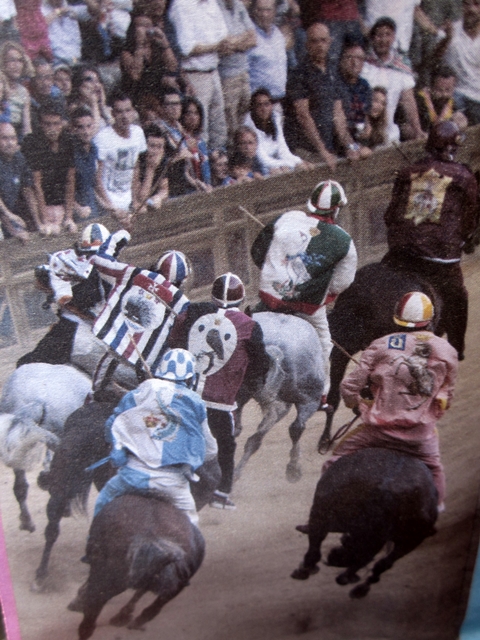
The Piazza is probably best known for Il Palio. It is a horse race that is held twice each year, in July and August. Ten horses and riders, bareback and dressed in the appropriate colors, represent ten of the seventeen city wards.
The race itself, in which the jockeys ride bareback, circles the Piazza del Campo, on which a thick layer of dirt has been laid, three times and usually lasts no more than 90 seconds. It is common for a few of the jockeys to be thrown off their horses while making the treacherous turns in the piazza, and indeed, it is usual to see unmounted horses finishing the race without their jockeys.
The race is the back drop for a segment of Herman Wouk’s “Winds of War” miniseries.
A pageant, the Corteo Storico, precedes the race, which attracts visitors and spectators from around the world. 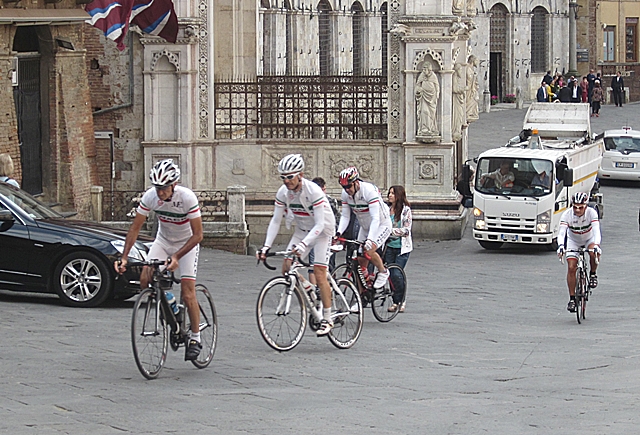 We didn’t see Il Palio that day, but we did see some bikers circling the Piazza.
We didn’t see Il Palio that day, but we did see some bikers circling the Piazza.
 We also saw a wedding in progress at the Palazzo Pubblico.
We also saw a wedding in progress at the Palazzo Pubblico. We went to see the public market. It had just closed for the day. Mary Ann, however, did enjoy this spectacular hanging flower.
We went to see the public market. It had just closed for the day. Mary Ann, however, did enjoy this spectacular hanging flower.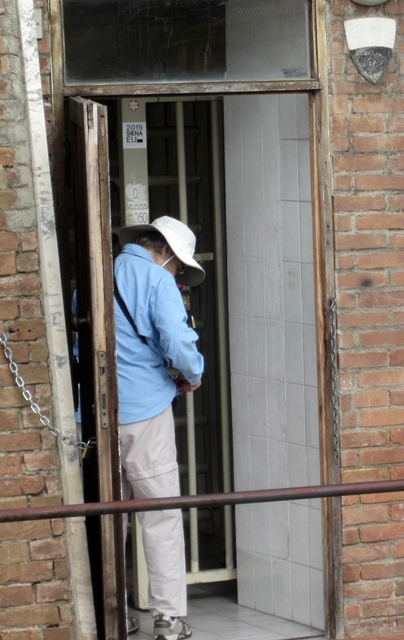
She didn’t enjoy fumbling for 50 Euro cents when she had “to go”.
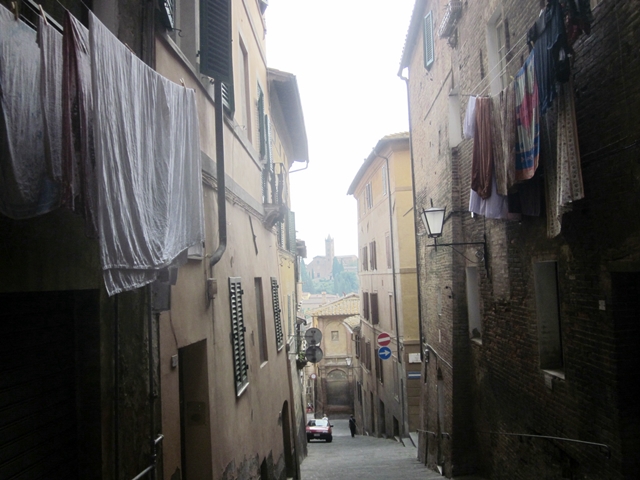 We wandered through the back streets. They were mostly narrow and steep.
We wandered through the back streets. They were mostly narrow and steep.
 We eventually arrived at Siena’s Duomo. The cathedral itself was originally designed and completed between 1215 and 1263 on the site of an earlier structure. It has the form of a Latin cross, a dome and a bell tower. The dome rises from a hexagonal base with supporting columns. The exterior and interior are constructed of white and greenish-black marble in alternating stripes, with addition of red marble on the façade. The Duomo in Orvieto had the same alternating stripes, remember?
We eventually arrived at Siena’s Duomo. The cathedral itself was originally designed and completed between 1215 and 1263 on the site of an earlier structure. It has the form of a Latin cross, a dome and a bell tower. The dome rises from a hexagonal base with supporting columns. The exterior and interior are constructed of white and greenish-black marble in alternating stripes, with addition of red marble on the façade. The Duomo in Orvieto had the same alternating stripes, remember?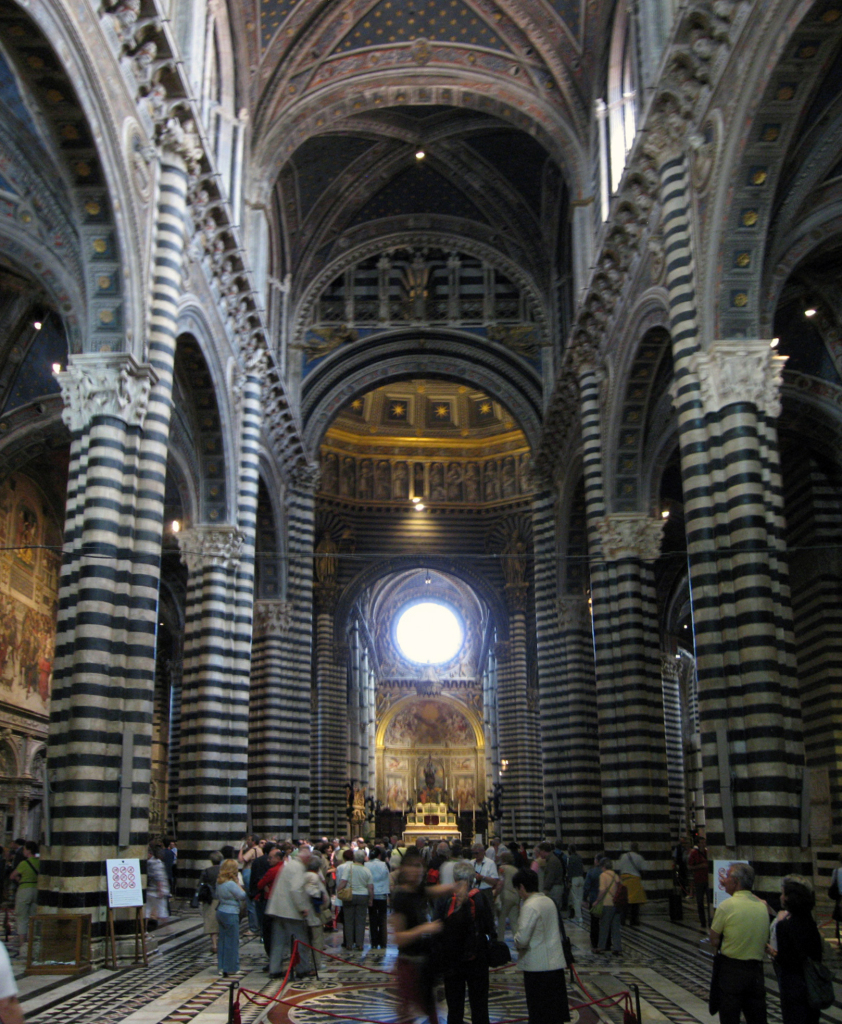 The alternating stripes really stand out in the interior.
The alternating stripes really stand out in the interior.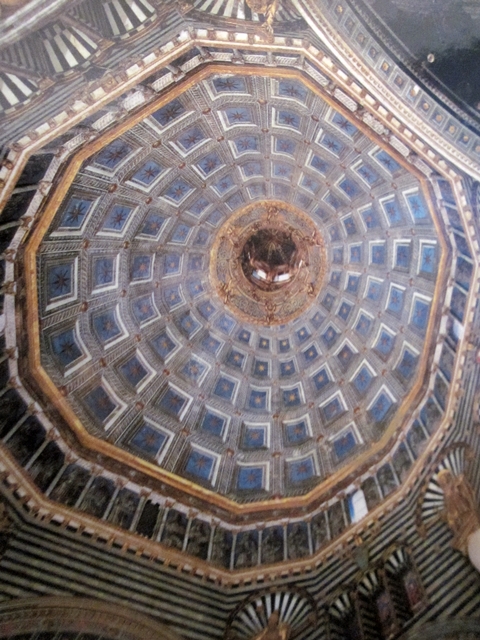
This is looking up at the inside of the hexagonal based dome.
Siena is built on hills. It’s up and down everywhere you go. We hiked down a looong steep walkway and up a looong set of stairs to get to the Basilica of San Domenico in the distance.
The church was begun in 1226-1265, but was enlarged in the 14th century resulting in the Gothic appearance it has now. However, many aspects of the Gothic structure were subsequently destroyed by fires in 1443, 1456 and 1531, and further damage later resulted from military occupation (1548-1552).
It is a large edifice built of brick, with a lofty bell tower (this was reduced in height after an earthquake in 1798). The interior is on the Egyptian cross plan with a huge nave covered by trusses and with a transept featuring high chapels.
The church contains several relics of St. Catherine of Siena, whose family house is nearby.
We were pooped after our loong hike down and up and we were also hungry and thirsty so we settled into a nice covered outdoor patio of the “Mascalano” restaurant near the church. Mary Ann had a bowl of hearty Italian soup and bread and I had lasagna. We bought this lunch (our first not scavenged ) with our savings on the train trip. It was delicious.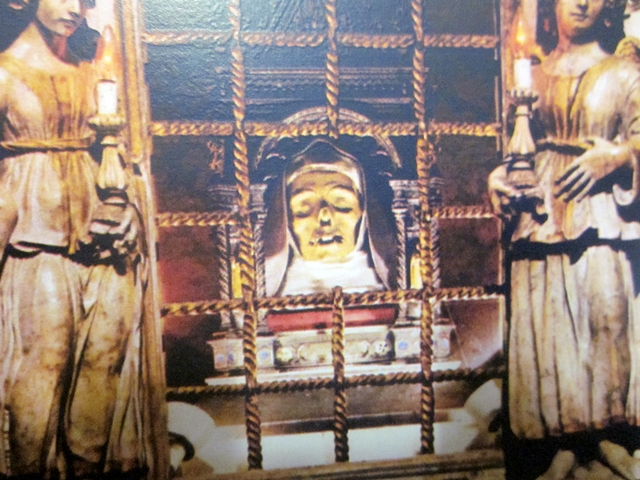 After lunch we went into the church to see Saint Catherine’s head. We looked at it so you might as well, too. It was kind of waxy looking.
After lunch we went into the church to see Saint Catherine’s head. We looked at it so you might as well, too. It was kind of waxy looking.
She was born 1347 in Siena and died of a stroke 1380 in Rome at the age of thirty-three. She had a short life, but after reading about her on the internet, an interesting and influential life.
I asked a local guy why her head was there and was told: “She was-a dead. She no need-a the head no more. So they took-a the head and put it here.”
On our way back o the train station we passed a soccer stadium. A game was in progress and the roar of the crowd was deafening. Unfortunately, the stadium was cleverly screened by trees and fences so we couldn’t watch the game.
We left Siena about 3PM for the 1 1/2 hour train ride back to Florence to join our group for dinner at a nice local restaurant. After that, we returned to our hotel for the night.
Thus endeth our days in Florence and Siena.
The next day, Sunday, we all boarded our bus to go to Santa Margherita via Pisa.
 Here is a look at the inside of the bus. The seats were comfortable, the driver was good, and the views along the way were interesting.
Here is a look at the inside of the bus. The seats were comfortable, the driver was good, and the views along the way were interesting.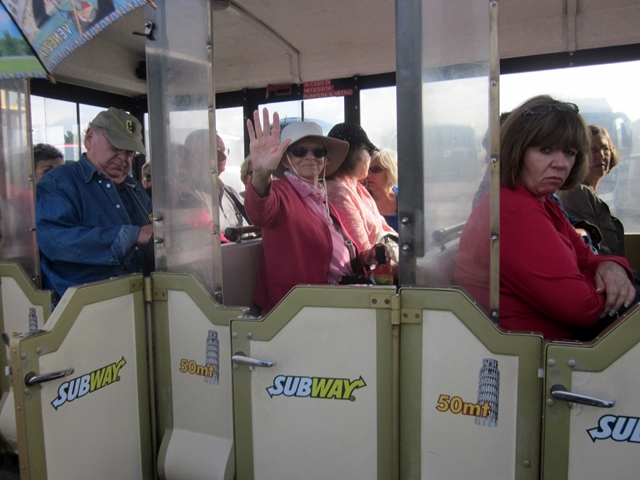 When we got to Pisa, the bus had to park in an outer lot (Sunday crowds) so we got on a little train for the ride to the tower. Note the “Subway” advertisement. Yes, Pisa had a “Subway” sandwich shop, but we already had our scavenged lunch.
When we got to Pisa, the bus had to park in an outer lot (Sunday crowds) so we got on a little train for the ride to the tower. Note the “Subway” advertisement. Yes, Pisa had a “Subway” sandwich shop, but we already had our scavenged lunch. Our first look at the “Leaning Tower of Pisa”. Yes, it was leaning!
Our first look at the “Leaning Tower of Pisa”. Yes, it was leaning!
Everyone was posing for the obligatory shot of holding up the Tower. I got Mary Ann to pose with the crowd. You needed to include the edge of the Duomo in order to establish a vertical reference.
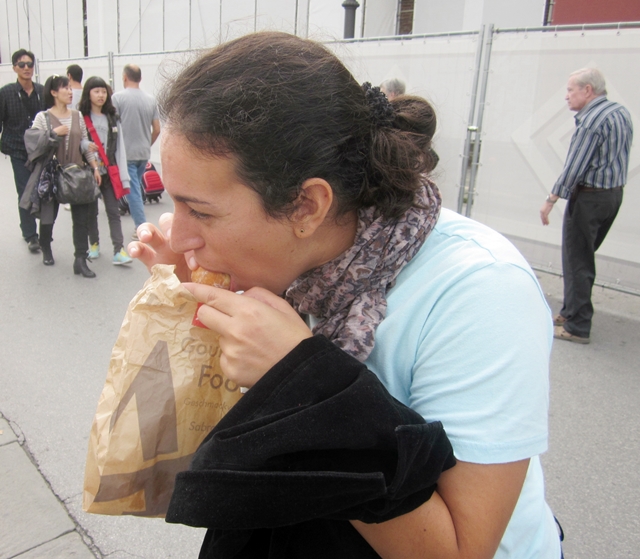 I had to get a shot of me eating a “Bombolini”. My son, Bob, said try one. We shared one with Eva, she our GCT Tour Director. Bomblinis are like filled Duncan Donut Munchkins.
I had to get a shot of me eating a “Bombolini”. My son, Bob, said try one. We shared one with Eva, she our GCT Tour Director. Bomblinis are like filled Duncan Donut Munchkins.
This was my first picture of Eva. I plan to include another on later. She was a super guide and did a lot of extra stuff to keep us busy. More later.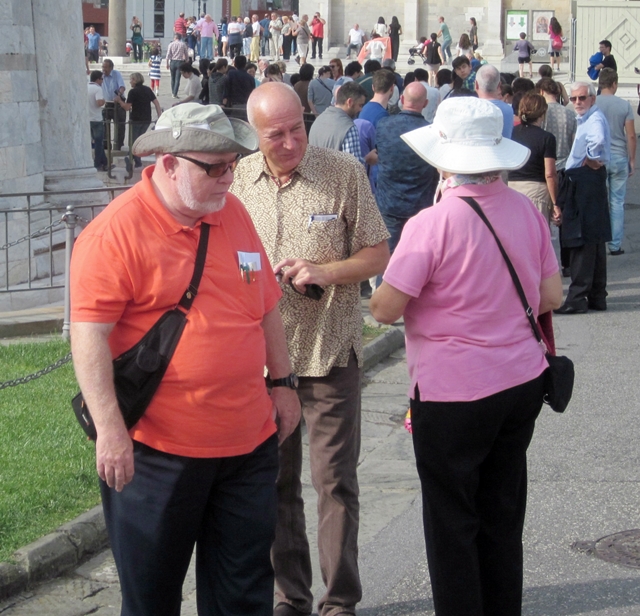 Here is Tracy and Randy, again. I didn’t get many pictures of our 40 other fellow tourists. I cant explain why. We were a good group and we all got along fine. Just no pictures. I guess Mary Ann did a lot on our own.
Here is Tracy and Randy, again. I didn’t get many pictures of our 40 other fellow tourists. I cant explain why. We were a good group and we all got along fine. Just no pictures. I guess Mary Ann did a lot on our own.

Here is the outside and inside of the Duomo. Mass was just ending so I went inside for a pic. Normally there is a 5 Euro charge to enter. It was getting so: “If you saw one Duomo, you saw them all”.
 Our helicopter view puts the whole area in perspective: There is the Tower, the Duomo, the Baptistry* (red roof), and the Cemetery (rectangular quadrangle). They are all located in the Field of Miracles ( the grassy areas surrounding the buildings). The whole area is located in a small part of the city of Pisa.
Our helicopter view puts the whole area in perspective: There is the Tower, the Duomo, the Baptistry* (red roof), and the Cemetery (rectangular quadrangle). They are all located in the Field of Miracles ( the grassy areas surrounding the buildings). The whole area is located in a small part of the city of Pisa.
*The Baptistries were where you once had to go to be baptized so you could enter the Roman Catholic Duomos. I don’t think this is a requirement these days.
 This is the last view of the Tower. These hardy folks paid their 5 Euros and climbed the 284 steps to the top. It must be a nice view!
This is the last view of the Tower. These hardy folks paid their 5 Euros and climbed the 284 steps to the top. It must be a nice view!
We reboarded our bus to continue on to Santa Margherita Ligure on the “Italian Riviera”.

